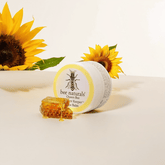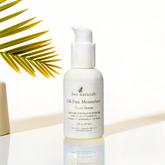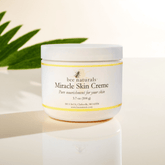Know Your Acids for Skincare
Acids in skincare are unsung heroes.
They are the miracle tools used to chemically exfoliate, even skin tone, and fight acne, age spots, wrinkles, and scarring. It can seem overwhelming to know which skincare products containing acids are best, but knowing the specific uses for each can be helpful in choosing products that are best for your unique skin type. Some acids are more well known than others, but they each have an individual purpose depending on your skin’s different issues, and we’ll discover that now.
|
Best for… |
Acid |
|
acne-prone skin |
azelaic acid, salicylic acid, glycolic acid, lactic acid, mandelic acid |
|
mature skin |
glycolic acid, lactic acid, ascorbic acid, ferulic acid |
|
fading pigmentation |
kojic acid, azelaic acid, glycolic acid, lactic acid, linoleic acid, ascorbic acid, ferulic acid |
The Different Types of Acids and Their Uses
The acids listed below are the primary acids skincare specialists work with that have been well researched in skincare. Keep in mind, acids are great for most people, but sensitive skin needs the selective de-squamatization delivered by enzymes, which are much gentler.
Azelaic Acid: Treats acne, papulopustular rosacea, hyperpigmentation/melasma, and aging skin. This is an awesome, multifunctional acid. Usual use: 20% on leave-on products.
Ascorbic Acid: AKA vitamin C. Comes in many forms, some more stable than others. Great for anti-oxidant effects, sun damage, and hyperpigmentation. We use primarily MAP (magnesium ascorbyl phosphate) vit C due to its stability and gentleness. Use range is typically between 5 and 20% (the work of Sheldon Pinnell, MD, from Duke University) He proposed the use of unstable L-ascorbic acid. We use stable MAP Vit C, instead.
Citric Acid: The baby sister of ascorbic acid. Citric Acid is a wonderful product for treating several skin problems like mild acne, pigmentation, clogged pores, sun tanning, wrinkles, and dark spots. Lemons, oranges, and certain berries contain citric acid in large quantities. You can apply citric acid on the skin, in the form of peels, toners, scrubs, or masks. Use is typically 1-5%.
Ferulic Acid: ferulic acid. A plant-based, phenolic antioxidant that is found in bran, among other plants. Research has shown that it provides antioxidant benefits to the skin while enhancing the stability of topical applications of antioxidant vitamins C and E. It also helps defend skin against environmental assault. Use is typically 1%.
Glycolic Acid: Is the holy grail for exfoliation, effectively removing the outermost layer of dead cells from the complexion, revealing brighter, fresher skin. Products that contain Glycolic Acid are used often to treat scarring, skin discoloration, and signs of aging, like fine lines and wrinkles. Use is typically between 5 and 35%.
Kojic Acid: is sometimes used in health and beauty products to lighten the skin. It may be used to treat skin conditions, such as sun damage, scars, and age spots. The science behind how kojic acid works as a lightening agent involves its effect on melanin production.
Lactic Acid: This is the hydrating acid that has many of the same effects as glycolic acid, but is milder for mature or sensitive skin. All alpha hydroxy acids exfoliate and improve skin texture, but lactic acid has an extra benefit you won’t get from its AHA cousins. Lactic acid helps improve the skin’s natural moisture factor, or the way the skin keeps itself hydrated. Basically, lactic acid helps to keep the skin moisturized and feeling less dry.
Malic Acid: Red wine contains antioxidants as well as malic acid, an alpha hydroxyacid. Both have scientific evidence showing they provide anti-aging and other skincare benefits. An antioxidant in wine, resveratrol, has been shown to be a very powerful antioxidant. It is a skin brightener.
Mandelic Acid: Softens and smoothes fine lines and roughness. It is derived from almonds. It is also an AHA. Mandelic acid is another alpha-hydroxy acid, one that’s derived from bitter almonds. Like glycolic acid, it’s an exfoliating agent that’s useful for preventing acne, treating sun damage, and evening out pigmentation. However, due to its larger molecular structure, it doesn’t penetrate the skin as deeply as glycolic acid, so it’s less irritating to the skin. For this reason, it’s commonly recommended in peels instead of glycolic acid, particularly for ethnic skin which is more prone to rebound pigmentation. Rebound pigmentation occurs when a resistance is built up to a particular substance due to excessive use. This causes the substance to not only be ineffective but often causes it to have the opposite of the intended effect.
Salicylic Acid: This is the only beta hydroxy acid and is used to treat acne and at lower doses, has anti-inflammatory effects. It is milder than AHA’s and helps keep pores clean. At concentrations above the usual 2%, salicylic acid has pronounced exfoliating and keratolytic effects that can soften calloused skin and corns.
Tartaric Acid: is naturally found in grapes and bananas, and when applied topically it can smooth the skin, enhancing your skin’s natural glow. Champagne, which is derived from grapes, is an easily available source of tartaric acid, and this detoxifying treatment is a great choice for a light alpha hydroxy mask.
The Three Main Types of Exfoliation
Many skincare experts recommend exfoliating the skin two to three times a week to tackle deep dirt and oil buildup, reduce dullness, and sweep away dead skin cells. Exfoliation promotes healthy cell turnover as they buff away the dead skin. There are three main types of exfoliation, and each has its benefits.
Mechanical – scrubs anything that is abrasive from mildly to extremely harsh. The mechanical exfoliation uses a product like a scrub to physically remove the skin cells by buffing them away.
Chemical – acids, primarily, which break down the keratin bonds of skin proteins (keratolytic) which reveals fresher, softer skin beneath. This is primarily the AHA’s (alpha hydroxy acids).
Remember, all clients who are treated with or use products containing AHA’s must be instructed to use sunscreen, or they will do further damage to their skin with UV exposure, thus defeating the purpose.
Enzymatic – these enzymes are very specific in what they break down, which is only dead skin cells, not live cells, thus making them more gentle and appropriate for those with sensitive skin.
Be Sure to Consult a Skin Care Specialist
When working with skincare acids and exfoliation, it’s important to work with a knowledgeable skincare specialist. They’ve been trained to help assist their clients in achieving their skincare goals in the safest way possible. We love to answer any questions our customers may have, so please feel free to contact us and we’ll be sure to help you with your skincare routine!







Leave a comment
Please note, comments need to be approved before they are published.